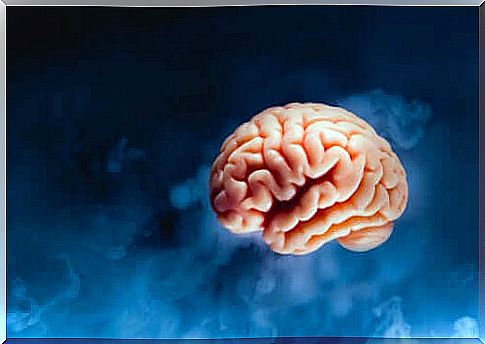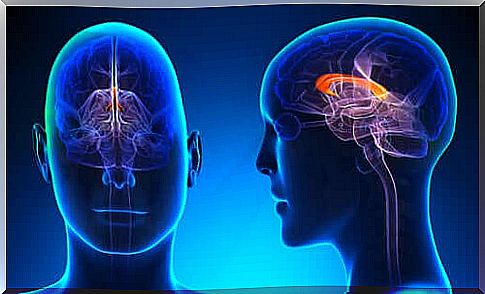Left-handed Brain: Key Differences

Have you ever thought about the difficulties left-handers face in a “world made for right-handers”? Currently, most designs are made with right-handed people in mind. While there are left-handed thinking tools, not everyone has access to them. This creates a need for adaptation on the part of those with a left-handed dominance, that is, a left-handed brain.
Today, we want to try to clarify what peculiarities the left-handed brain has, in addition to the adaptation needs it requires. We will also try to understand how left-handed people configure their activities at the brain level and how this can change. Let’s take into account a wide spectrum of variables: from anatomy to your performance in daily activities.

Laterality in the left-handed brain
We can say that a left-handed person is one who has the left body dominance or preference. Therefore, prioritize the use of your left foot, eye, hand and ear to perform any activity. This is defined by brain laterality.
Laterality develops from psychomotricity. It encompasses concepts such as developing the body schema, developing muscle to do some activities, and the balance needed to perform them.
Therefore, in left-handed bodies, the psychomotricity process is different from what happens in right-handed people. The left-hander strengthens and gives preference to your left side of the body.
As far as brain laterality is concerned, the process is different. To explain this point, it is important to clarify the hemispheric preference found in most brains. In the left hemisphere there is greater control over language functions and the sequential processing of information.
The right hemisphere, on the other hand, is mostly related to spatial activities and body information.
Therefore, brain laterality in the left-handed brain tends to have the same organization, but the functionality is often different. In other words, the way in which the left side of the body was stimulated caused the distribution of the body scheme, muscle development and balance to be stimulated in a different way. In this case, the brain prioritizes areas of the right hemisphere, without neglecting the left hemisphere.
In this sense, it is important to highlight that the complete definition of brain laterality coincides with a stage of acquisition of various school skills. This fact can have an impact on their development.
School skills in left-handed people
Laterality implies the preferential use of one hand to do school activities, such as writing. With this learning process, sensory and motor circuits are generated in areas involved in writing.
In the left-handed brain, although these circuits develop properly, there may be difficulties in this activity. This is due to the fact that, because of the way he writes, the left-hander cannot clearly see what he is doing.
This makes them more likely to make mistakes in the learning process. In addition, they also often stain their hands with ink when practicing this activity.
On the other hand, difficulties in reading were also observed. This is due to the fact that the innate orientation would be to read from right to left, contrary to what happens in languages such as Portuguese and English, in which reading occurs from left to right.
This creates difficulties in the organization of reading, causing a possible delay in the acquisition of this skill.
Another of the difficulties in the school environment is the rapid fatigue that left-handers present when carrying out activities with pencil and paper or manuals, such as cutting.
They tend to be slower in developing these activities, as they need to calculate the direction of their strokes. In addition, they must be more careful not to stain their work due to the movement of the hand over their lines.
Does the left-handed brain have any advantage in creativity?
Among the characteristics that are attributed to the left hemisphere are spatial and visual skills, creativity, synthesis capacity and artistic talent. So the idea arose that the left-handed brain is more sensitive, creative, and imaginative.
This is due to the stimulation that occurs in this hemisphere during its development, which may give more importance to this characteristic. Thus, left-handers would more easily develop tasks that require greater creativity, such as art.
Some of the most renowned examples of left-handed people are world-renowned artists such as Leonardo Da Vinci, Rafael and Michelangelo.
Still, it is important to clarify that being right-handed does not prevent the development of this ability. What happens is that the left-handed brain, having this constant stimulation, can have advantages in the development of these aspects.
Psychological characteristics of the left-handed brain
Functional imaging studies have found that the size of the corpus callosum is larger in the left-handed brain. The explanation for this point lies in the fact that, in order to properly integrate information and correctly carry out activities, the brain needs to generate more inter-hemispheric connections.
Furthermore, it was found that, in the left-handed brain, the direction of directionality and rotation is different. In activities where left-handers need to rotate some element, they do it clockwise.
Another interesting point is the way in which graphical information is processed, from right to left. All of this created advantages, such as more easily abstracting three-dimensional objects and more precisely developing visuospatiality.
Another characteristic found in people with a predominance of the right hemisphere has to do with the way they acquire knowledge of the environment. In this case, they tend to outline the whole, then focus on the details. This makes it easier for them to achieve coherence or unconventional solutions to everyday problems.

Flexibility and Adaptation
In many cases, people with a left-handed brain are put under pressure since they are children to adapt to a world that is made for right-handed people. As a side effect, this pressure, in many cases, makes left-handers more adept at the psychomotor level. They would also have better inter-hemispheric connections, making it easier to learn new information.
This adaptability also increases flexibility, especially cognitive. This gives them greater competence in activities related to multitasking skills and to establish innovative solutions adapted to changing demands.
Conclusion
To conclude, it is important to understand that left-handed people live in a world designed and thought for right-handers. Thus, it is they who, in many cases, need to adapt. This makes the left-handed brain train some strategies that can give you a cognitive advantage in some situations.
Although there are difficulties in acquiring reading and writing learning, they develop strategies to complete this learning. Likewise, the advantages in creativity that come from stimulating the right hemisphere make it easier for your brain to create alternative solutions.









